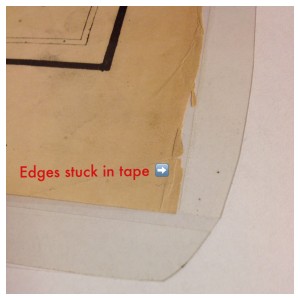Have you noticed that the most simple-seeming projects always turn out to be more complicated than you think? As part of our preparations to move our collections to our renovated library, we are trying to free up space in the flat files. Our flat files contain broadsides, maps, posters, artwork, etc. Many of these items are large and flat and should be in the flat files. Many are flat but are small enough to fit into standard manuscript boxes or pamphlet binders. Last November we embarked on a project to help the Rubenstein Library move as many of the smaller maps as possible into enclosures to free up space in the flat files. Sounds easy, right?
First Challenge: To Keep the Old Encapsulation or Not
I am an advocate of NOT encapsulating materials unless it is necessary to facilitate handling. Polyester is expensive, and it can add a lot of weight to the stacks. It can also make handling difficult for patrons as they sift through a stack of slippery encapsulated documents.
Many of these maps didn’t need to be encapsulated. They are in good condition and a folder inside a box would suffice. However, in order to finish the project by the move date, we would need to utilize our student assistants and our volunteer. If we decided to de-encapsulate materials, it would mean a conservator would have to evaluate the condition of each item to determine its disposition. There simply wasn’t time to do this.
In consultation with Rubenstein staff, we decided the maps would stay encapsulated in their old polyester if possible. We would replace the polyester only if an item didn’t fit its current encapsulation, or if the old polyester was too damaged to keep.
Second Challenge: All That Tape!
Almost all of the maps have been previously encapsulated using double stick tape to adhere the two pieces of polyester together. While this is a common method of encapsulation, it poses one big problem. A document can shift to the edge and become stuck. This poses a particular hazard for brittle materials. Lucky for us, most of our maps were encapsulated with a generous amount of space between the object and the tape.
We decided that we could ultrasonically weld between the object and the tape, trim the tape off, and voila! A retrofitted encapsulation.

Third Challenge: Size Matters
As we looked through the thirty drawers of materials it became clear that some of the old encapsulations just weren’t working. There were several items that had encapsulations that were too small. Some large folded items were put still folded into an L-sleeve encapsulation. Handling is awkward, and unfolded these items became too large for either the manuscript boxes or the flat files.
Rubenstein staff decided on two standard manuscript box sizes and two standard pamplet-binder sizes. Anything that could go into one of these would do so. Any folded item would be unfolded. If an item was too big for a box, it would remain in a folder in a flat file. If it was too big to lay flat in the current flat files, we would wait to encapsulate it until we were in our new space with our new, bigger flat files. There are a few items that are in too bad of a condition to safely re-encapsulate. These will come to conservation for treatment first.

Fourth Challenge: The Weird Stuff
There is a lot of weird stuff in libraries and not everything in the map drawers are maps. As we work our way through the map collection we are setting these oddities aside for curatorial review. Some will end up back in the flat files, some will be the responsibility of Collection Development to deal with.
The Project So Far
To date we have encapsulated 1,865 items. By our estimates we are about 90% finished, but what is left is some of the oddball items that need special attention by conservation, curators and by technical services. Technical services will also have to update the new locations, which they will do during the reclass project. Did I mention Rubenstein is also doing a huge reclass project during the move? We don’t believe in doing only one huge project at a time, that would be too easy.


How lucky that you could weld many of the taped encapsulations! I worry whenever I see brittle items anywhere near that tape.
We are lucky to have an ultrasonic welder. I do teach a safer, low-tech version of encapsulating with double stick tape. Method: Cut your polyester to size (two pieces). On one piece, attach the double stick tape at the edges. Cut a piece of 18/3 unbleached linen thread to the length of the tape line (do this for all four sides). Abut the thread just so it hits the edge of the tape (the thread is between the tape and the object, and should be a barrier between the object and the tape; no sticky tape should extend beyond the thread). Then align the second piece of polyester on top. This allows the item to shift but when it does it hits thread rather than tape. I hope that makes sense.